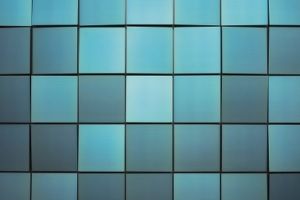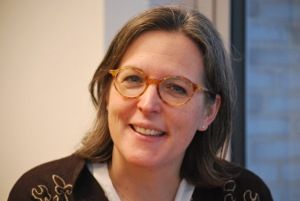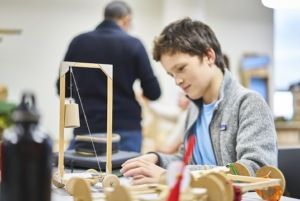When you approach the school from the land side, the first thing that strikes you is the fact that to all intents and purposes, side on it resembles a stack of blue and turquoise containers.
This is no accident; the building is situated on Levantkaj, one of the few remaining working parts of Copenhagen’s north harbour port, and the container port is one of the school’s neighbours.
To enter CIS, you have to ascend a gently inclined ramp on the side of the building away from the water. This takes you through a wide doorway and directly into a large open area, dominated by wooden steps dramatically descending to the level below where the canteen is situated.
The overwhelming impression is one of the warm colours of pale brown wood, glass and light – lots of light.
A small town atmosphere
Anders Smith, an architect and designer, has been the prime mover behind the construction of the school. He is on the board of ECIS, the body set up to see the building project through, raise funding for it and rent the finished school building to CIS. Eventually, if all goes well, it may be possible for ECIS to donate the building to CIS.
Anders points out that the school ought to be looked at like a town. “We created a plinth that can be seen more as a cultural centre or town. You arrive in the ‘city square’ – which is about your stomach or your brain. That’s how people usually meet.”
One of the main ideas behind the school is getting as much light in and also, regulating that light in some extremely technically sophisticated ways. Natural light reflects what is happening outside but the intensity of it also affects a person’s circadian clock.
“Research has shown that if you have natural light from two sides and lots of it, you perform 30 percent better in maths tests, so why not build a building that can give you that,” asks Smith. There is energy-saving LED lighting everywhere and the colour and intensity can easily be turned up or down as well by the class teacher, depending on the effect the teacher requires.
Knocking down the walls
“You will also see that we have glass walls throughout. We wanted to be more open than we were before. As we all know, walls are about keeping things out and we would like to invite people in,” he added.
It was also an important part of the brief to devise a ‘school for the future’. In this regard, the innovative way the walls are arranged is a vital part of it, as it is impossible to predict what educational patterns or methods might require 50 years hence. Unlike most other schools, there are no two rooms in the school that are alike.
“We looked at various systems involving foldable walls and found out that they didn’t work – as well as being expensive. The model for us was to make differentiated spaces. As no two rooms are identical, you can find a space that fits your needs,” said Smith.
Sustainability to the fore
Naturally also, sustainability is an extremely important aspect. The building has no less than 12,000 solar panels and they generate 50 percent of the power requirements of the school. And they are not just any old solar panels. Smith has developed an innovative solution here too.

The panels are used as cladding on the building and appear more as blue tiles. Each one is angled slightly differently so that the overall effect is pleasing on the eye and not monolithic. As Smith proudly says, “this is one of the world’s largest photovoltaic building integrations. Nobody else has put this many solar panels on a building – or used them as a facade.”
There is a system for collecting data from the energy production as well as the energy use from the panels and these figures can be used as part of the teaching process.
Director of Communications, Thomas Nielsen, added that “the emphasis on sustainability is really important from a theoretical point of view but also to try and live it. I like to tell students that sustainability doesn’t mean doing without; it’s not a monk-like existence! You can actually build a fantastic facility and at the same time, be conscious of your carbon footprint and other aspects of sustainability.”
Nielsen went on to say that “understanding the connection between your own everyday practice as a world citizen and your impact on the environment is something that is pretty unique to this school. There are so many ways we can remind each other of this; why not cover the facade in solar panels and use the data to demonstrate to the kids that it works?”
As well as the solar panels, in the design phase the school wanted to be even more sustainable. However, the regulations governing school buildings in Denmark have so far stymied their ideas for using ‘grey water’ to flush toilets and for use in the fire sprinkler system.
Social sustainability
As well as environmental sustainability, social sustainability is equally important. Smith points out that integration across the different ages was also part of the plan. “One of the things we were afraid of losing [from the old school] was the interconnectivity between the ages. A young child learns an awful lot from those who are a little bit older and the older children learn how to deal with the younger ones.”
The classrooms are situated on the corners of the four towers of the building and each floor has children of the same grade. This is to create peer groups to make the children feel at home. The classes are kept low number-wise in order that meaningful social relationships can develop. The classes are also mixed each year so that the children feel that their cohort is their age group and not just their small class. “The dream is to build a better society by actually knowing people. With 84 nationalities we need to know them all,” said Smith.
IB – a new way of learning
And what of the teaching and learning that goes on here. Is that as innovative as the building? CIS uses the International Baccalaureate system (IB), which is a truly international form of education. The IB system also places a lot of emphasis on educating the whole child.
School director Jennifer Weyburn, who comes from a background of international schools in the US and China explained. “One thing that fits here is that we believe that the education of the child is not only in the academic classes; it’s also about social/emotional learning and being part of a community.”

Although the IB system seems different in many ways, it does have a very traditional examination system. Unlike many other programs, course work during the year does not count towards the final grade you get in an examination. As well as this, there are very few oral exams, except for those in languages.
If this seems a little old-fashioned, Nielsen explains that it is necessary because IB is a global program, so it would be difficult to include continuous assessment across such a wide range of countries and individual teachers. As it is, exams are set by the IB Board and a number of censors worldwide grade the papers. There is also a moderator system on top of that to ensure that the grading methodology is the same everywhere.
Developing critical thinkers
Weyburn went on to say that she felt that children taking this type of education came out with deeper critical thinking skills, as well as having the ability to research and engage with their learning and research.
The strength of the IB program is that it does not look at the world though any particular national lens. Students are taught to look at reality through a number of angles and perspectives and through that, realise how reality changes depending on which perspective you have.
A hands-on approach
Nielsen explained that the IB system was firmly based on the idea of learning through activities. “Students are not just presented with the right answers and solutions, they also learn how to ask the right kind of questions and how and where to look for solutions themselves.”
The IB also provides a much more holistic approach to education because the children are exposed to a lot of creativity and physical activity. The school has a number of gyms, rooms for music practice and theatre spaces and the visual arts play an important role.
One of the subjects on the curriculum is Design Tech. This is a way of working with intellectual problems and seeing how they manifest themselves in the visual world.
“Right now, grade 6 are working on a project to do with sustainable vehicles. What modes of transport are most sustainable? What do you need to look at when you develop this kind of vehicle in terms of resistance, traction etc?”

“In this project, the students actually build model cars to investigate things first-hand,” added Nielsen.
Polyglots all
The ratio of staff to pupils is also somewhat higher than at a traditional school. There around 200 teachers to 970 students. The students are as diverse a bunch nationality-wise as you could hope to find. At present, there are 84 different nationalities represented, so language is a big focus.
“If you don’t have the language skills you’re not going to be able to interact with people around the world,” adds Weyburn.
Everyone at the school speaks English and they also have their own mother tongue, which is often another language. On top of that, the students are taught Danish from the primary to secondary years. After that, they can decide to pick another language. “We’re aiming for our students to be at least bilingual if not trilingual,” Weyburn says.
Even though the children might leave before going through the whole school process, Danish can be useful but more in terms of the metacognitive result of learning a language. It is also the thought process and the flexing of the brain that is important here.
A great responsibility
Nielsen mentions that in the school’s mission statement, the vision is defined as ‘educating champions of a just and sustainable world’, with the duality that the world ‘champion’ implies. It’s not only about turning out the best students, but also students who are going to fight for these ideas.
The mission is ‘learning to build a community’ by developing the potential of each student through offering educational excellence in a stimulating environment of cultural respect.
Weyburn is very proud of the school and feels that being an educator is the best job in the world because you have a responsibility for other peoples’ children.
“Every day the professional staff is trying to foster and support every child and getting a whole organisation to do that is tough! But it is the most exciting work ever because the students and families have entrusted themselves to us.”
Looking round at the groups of students going about their business in the school and in its classrooms, gyms and music rooms, it certainly seemed as if she was on the right track.














